Use the Machining page to specify the offset profile, order, and direction for blisk machining strategies. The available options are dependent on the selected strategy:
Machining
Cut direction — Select the milling technology.
- Climb — Select to create toolpaths using only climb milling, where possible. The tool is on the left of the machined edge when viewed in the direction of tool travel.
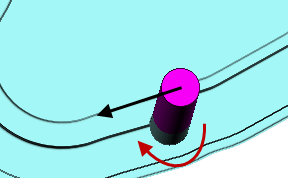
- Conventional — Select to create toolpaths using only conventional or upcut milling, where possible. The tool is on the right of the machined edge when viewed in the direction of tool travel.
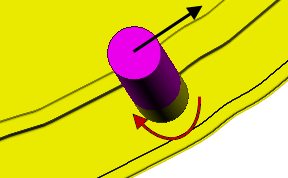
- Any — Select to create toolpaths using both conventional and climb milling. This minimises the tool lifts and tool travel.
Offset — This defines how to offset from the hub profile to the shroud profile.
Off — Only machines the last slice, closest to the hub.
Offset down — Offsets the shroud profile. The offsets continue as an offset of the shroud until the hub profile is reached, at which point the hub profile is followed.
Offset up — Offsets the hub profile.
Merge — Starts by offsetting the shroud profile and slowly migrates the offset so that at the end it's offsetting the hub profile. An example of an Offset of Merge is shown below:
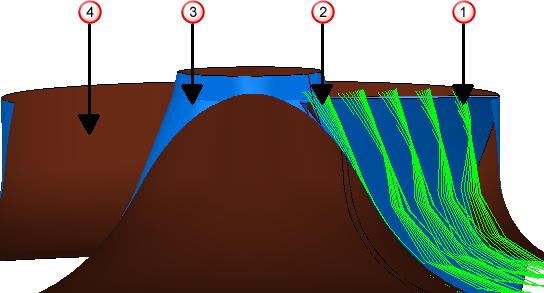
 — the first offset which follows the shroud profile.
— the first offset which follows the shroud profile.
 — the last offset which follows the hub profile.
— the last offset which follows the hub profile.
 — the hub.
— the hub.
 — the shroud.
— the shroud.
The profiles between the first and last offsets gradually change from the shroud profile to the hub profile.
Method — Select the offsetting method between the two blades. This option is only available for Blisk Area Clearance strategies.
- Parallel — The offsets are approximately parallel to the blades.
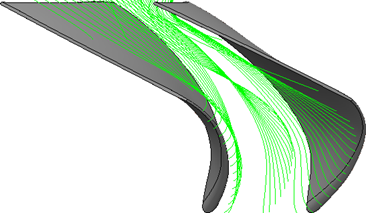
- Trochoidal — The offsets are approximately perpendicular to the blades, but with the edges rounded off. Each pass loops before joining the next one to create something resembling a trochoidal path. Selecting this option enables the
Trochoids area of the dialog.
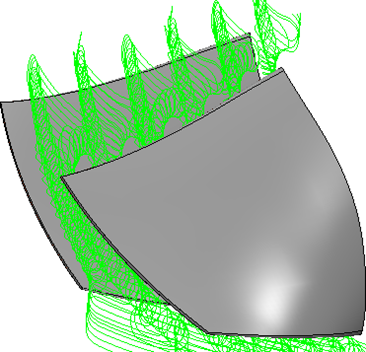
Operation — Select which faces of the blades are machined. This option is only available for Blade Finishing strategies.
- Machine left blade — This machines all the faces of the left blade. This option minimises the number of lifts.
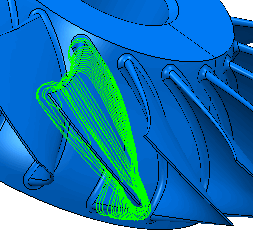
- Machine all faces — This machines all the faces in the pocket.
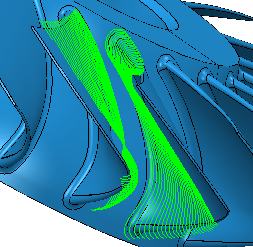 Note: Machine left blade and Machine all faces produce toolpaths encompassing the whole blisk (assuming the blisk has no splitter blades) if the Machine > All blades option is selected on the Blade area of the Blade finishing page. However, the actual toolpaths and leads and links are different.
Note: Machine left blade and Machine all faces produce toolpaths encompassing the whole blisk (assuming the blisk has no splitter blades) if the Machine > All blades option is selected on the Blade area of the Blade finishing page. However, the actual toolpaths and leads and links are different.
Machine splitter — This machines all the faces of the splitter.
Left and splitter blades — This machines all the faces of the left blade, and all the faces of the splitter.
Order by — Select whether machining takes place by Region or by Level.
- Region — When selected, one region (such as a pocket or boss) is completely machined before going on to the next. So, pockets are machined in preference to levels.
- Level —When selected, one level is completely machined before going down to the next. So, levels are machined in preference to pockets.
The Order by option is available only if you select a Machine of All Blades in the Blades area on the Blade finishing or Blisk area clearance page.
Start position — This specifies whether the machining starts at the top or the bottom of the blade.
Spiral — This generates spiral toolpaths between the consecutive closed passes of a blade. Spiral works best when you use an Offset of Merge. If you select Offset up or Offset down, the toolpath may contain open passes, which cannot form part of the spiral.
Trochoids
The following options are only available if you select a Method of Trochoid:
Radius — Enter the preferred radius for the rounding at corners.
Minimum radius — Enter the minimum radius for the rounding at corners.
Connection clearance — Enter the tool retract distance for the back of the trochoids (the portion of the toolpath which is air cutting).
- Connection clearance of
20
compared against a
Connection clearance of
5.
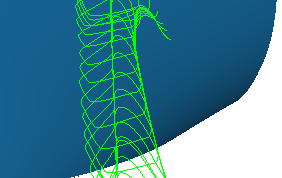
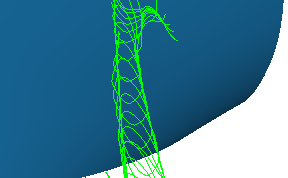
Overlap — Each pass overlaps the previous pass by the distance specified here. Each pass starts before the previous pass curves away from the edge.
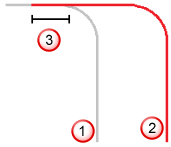
 First pass
First pass
 Second pass
Second pass
 Overlap
Overlap